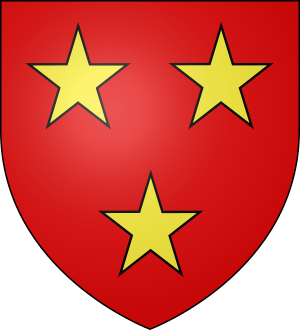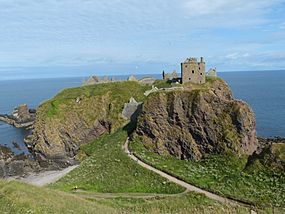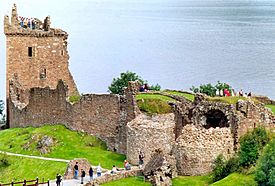William de Moravia, 5th Earl of Sutherland facts for kids
Quick facts for kids
William de Moravia, 5th Earl of Sutherland
|
|
|---|---|

de Moravia Earl of Sutherland Coat of Arms
|
|
| Born | Unknown |
| Died | 1370 Sutherland, Scotland |
| Allegiance | Scotland |
| Battles/wars | Siege of Kildrummy Castle (1335) Battle of Culblean Siege to Cupar Castle Foray into England (1340) Capture of Roxburgh Castle Battle of Neville's Cross |
| Relations | Kenneth de Moravia, 4th Earl of Sutherland (father) Margaret Bruce (wife) John of Sutherland (son) Robert Sutherland, 6th Earl of Sutherland (son) |
William de Moravia (also known as William Sutherland) was an important Scottish noble who lived in the 1300s. He was the 5th Earl of Sutherland and the leader of Clan Sutherland, a famous Scottish clan from the Scottish Highlands. William was a very loyal supporter of David II of Scotland, especially during Scotland's wars against England. He died in 1370.
Contents
Early Life and Family
William was the son of Kenneth de Moravia, 4th Earl of Sutherland and Mary (or Marjorie) of Mar. He became the Earl of Sutherland in 1333 after his father passed away.
William married Margaret Bruce, who was a daughter of King Robert the Bruce (Robert I of Scotland). She was the daughter of Robert the Bruce and his second wife Elizabeth de Burgh. They got special permission from the Pope for their marriage in 1342.
With Margaret Bruce, William had one son:
- John of Sutherland: He was supposed to become king of Scotland because his mother was King Robert the Bruce's daughter. But John died from the plague in London. So, Robert II of Scotland, who was King David II's nephew, became the next king instead.
Later, William married his second wife, Joanna. She was the daughter of Sir John Menteith. They had these children:
- Robert Sutherland, 6th Earl of Sutherland: He became the next Earl. From this point, the family fully used the surname Sutherland.
- Kenneth Sutherland: He was the first leader of the Sutherland of Forse family branch.
- John Beg Sutherland.
Fighting for Scotland
Wars of Scottish Independence
William, the 5th Earl of Sutherland, played a big part in the Wars of Scottish Independence. These were long conflicts between Scotland and England.
In 1335, some historians say William helped Andrew Moray and the Earl of Dunbar lift the siege of Kildrummy Castle. He also might have fought in the Battle of Culblean. Other records suggest he joined other Scottish earls in trying to capture Cupar Castle in Fife, which was held by the English. However, this attempt failed.
In 1340, William joined the Earl of March on a raid into England, but they were pushed back.
King David II's Return
David II of Scotland had been in France for nine years. When he returned to Scotland in 1341, he seemed to really like the Earl of Sutherland.
Some say William, Earl of Sutherland, successfully took Roxburgh Castle back from the English. This castle was very important. While one historian says this happened in 1340, it was more likely in 1342.
Because William was married to King David II's sister, Margaret Bruce, the King gave him many land grants. These included lands in Forfarshire and Aberdeenshire.
In 1346, William and his wife were given Dunnottar Castle in The Mearns. They were also allowed to build a fort there. However, it's not clear if William actually built a fort. The castle we see today is usually linked to another noble, Sir William Keith. William likely gave up Dunnottar Castle in 1358.

Battle of Neville's Cross
Also in 1346, William joined the Scottish army that gathered at Perth and then invaded England. This led to the Battle of Neville's Cross. The Scottish army was defeated. An English historian wrote that William was killed, but this was wrong. He was actually taken prisoner by the English.
In 1351, William was allowed to travel to Newcastle upon Tyne for talks about King David II's ransom. Later that year, he helped escort King David back to Scotland. William's son, John of Sutherland, who was the king's nephew, was sent to England as a hostage to ensure King David would return if needed. John was a hostage again in 1354.
In 1357, William and his son John were exchanged for King David. They traveled to London and stayed under the care of the English Chancellor. William stayed in England for ten years. He was allowed to travel between England and Scotland at times. He was finally set free around 1367.
More Land and Gifts

In 1358, William gave up some of his lands in Kincardine to the king. In return, the king gave William and his son John the area of Urquhart and Urquhart Castle in Inverness-shire. However, the king later gave William back his lands in Downie, Kincardine, and Aberluthnot.
In 1360, William gave land to his brother, Nicholas Sutherland, 1st of Duffus. The Sutherland Lairds of Duffus family came from this Nicholas. In 1362, William gave the chapel of St John the Baptist at Helmsdale to the monks of Kinloss Abbey.
William and his second wife, Joanna, were given special permission to visit the shrine of St Thomas at Canterbury Cathedral in 1362.
Feud with the Mackays
William, Earl of Sutherland, had a long-standing feud with the Mackay family of Strathnaver. This conflict caused a lot of fighting and bloodshed between the people of Sutherland and Strathnaver.
One historian, Sir Robert Gordon, wrote about this feud. Another historian, Angus Mackay, found that William, 5th Earl of Sutherland, mentioned an "ancient enemy" in 1342 when he asked the Pope for permission to marry Margaret Bruce. This "ancient enemy" caused "wars, disputes and many offenses." If the Mackays were related to an older family called the MacHeths, then they would indeed be an "ancient enemy" of the Sutherlands.
In 1370, a meeting was set up in Dingwall to try and end the dispute between the Earl of Sutherland and Iye Mackay, the Mackay chief. William, his brother Nicholas Sutherland, Iye Mackay, and Iye's son Donald were all there. It seemed like Mackay was about to win his case.
However, Nicholas Sutherland, William's brother, secretly killed both Iye Mackay and his son Donald during the night. This happened at Dingwall Castle. Some historians believe the Earl of Ross and possibly the Earl of Buchan were also present as judges.
This feud might have been made worse by royal politics. In 1345, King David II gave the Earl of Sutherland great power in Sutherland. William's son, John, was even a possible heir to the throne. But when John died, King David's nephew, Robert II, became king. At this time, the king's doctor was Farquhar Mackay, Iye Mackay's son. The king also gave Farquhar Mackay some lands. It seems the king might have favored the Mackays to put pressure on the powerful Earl of Sutherland.
So, when Iye Mackay was close to winning his case against the Sutherlands, he and his son were murdered by Nicholas Sutherland in 1370.
Death
William, Earl of Sutherland, died in 1370. This is supported by records showing that Urquhart Castle, which belonged to him, was back in the king's hands in 1371. Some people think he might have been killed in revenge for his brother Nicholas murdering the Mackay chiefs in the same year. It is confirmed that William was definitely dead before 1389, when his son, Robert, became the Earl of Sutherland.


